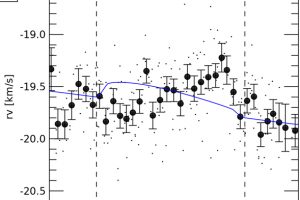An iron-rich atmosphere for the planet KELT-9b. The study: “The GAPS Programme with HARPS-N at TNG. XIX. Atmospheric Rossiter-McLaughlin effect and improved parameters of KELT-9b” of F. Borsa (INAF-OA di Brera) recently appeared on A&A

To date (October 2019), 4073 exoplanets have been confirmed, while 4495 are still candidates. The vast majority of these exoplanets have been discovered with two techniques: the analysis of transits (e.g.: measuring the decline of stellar luminosity during the passage of the planets in across the stellar disk) and radial velocity (by detecting, thanks to the Doppler effect and spectroscopic observations, the oscillations of the stars around its position due to the gravitational interaction with the orbiting planets). Recently, the exoplanetary science is pushing over the search for exoplanets, by detecting their atmospheres, and studying some of their properties, such as composition and the thermal profile.
The GAPS (Global Architecture of Planetary Systems) project is one of the international projects aimed at studying exoplanets in which the Italian National Institute of Astrophysics (INAF) is involved. The objective of the project is to study the architecture of known exoplanetary systems in order to better understand their formation and evolution. The project is based on observations made with two high-resolution spectrographs mounted on the Telescopio Nazionale Galileo: HARPS-N operating in the optical bands and GIANO-B in infrared (the simultaneous observations in optical and infrared allows to distinguish between the radial velocity signal due to orbiting exoplanets from the signals due to the stellar magnetic activity).
The star KELT-9 is one of the GAPS targets. It is an A star (with an effective temperature of 10000 degrees) hosting a hot-Jupiter (e.g. Jupiter mass planets orbiting very close to their stars), named KELT-9b, with an orbital period of 1.48 days. It is one of the hottest planets among the GAPS targets. Existing studies have demonstrated the presence of an evaporating atmosphere (with a mass loss rate of 1012 g/sec, likely underestimated), with presence of iron (neutral and ionized), ionized titanium and neutral magnesium.
The GAPS observations, described in the paper: “The GAPS Programme with HARPS-N at TNG. XIX. Atmospheric Rossiter-McLaughlin effect and improved parameters of KELT-9b” of the astronomer F. Borsa (INAF – Astronomical Observatory of Brera), have allowed to find another clue about the presence of a rich atmosphere around the planet KELT-9b. During the transits of this planets, in fact, the astronomers have observed the Rossiter-McLaughlin effect, which is often observed during transits. This effect consists in an alteration of the radial velocity signal due to the transit. In fact, since stars rotate around their spin axis, we observe half of the star moving toward us and the other half mowing away. This produces a Doppler effect in both senses that results in a broadening of the spectral lines. However, during a transit, the planet eclipses first half of the star and then the other half, affecting the final radial velocity signal. It is possible to account for this alteration once the orbital parameters of the planets are known. However, in the case of KELT-9b, it was not possible to reproduce the observed radial velocity signal including only the orbit of the planet and the Rossiter-McLaughlin effect. The authors have thus demonstrated the it is necessary to introduce another effect which is due to the iron-rich atmosphere of the planet, named by the authors as Atmospheric Rossiter-McLaughlin effect. This study recently appeared on Astronomy & Astrophysics. The astronomers L. Affer, S. Benatti, A. Garrido Rubio, A. Maggio, J. Maldonado, and G. Micela of INAF – Astronomical Observatory of Palermo are among the co-authors of the paper.
The figure (link) shows the radial velocity curve of KELT-9 averaged in phase, with the expected signal due to the orbit of the planet and the Rossiter-McLaughlin effect. Without considering the effect due to the planets atmosphere, the theoretical curve clearly does not fit the observed data.
